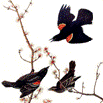Center, Internet, Wildlife Damage Management

Bird Control Seminars Proceedings
Document Type
Article
Date of this Version
September 1968
Abstract
My travels the last few years have permitted me to see some aspects of bird management practices in both Asia and Europe. I must confess that had I not seen the Tori gates of Japan or the cathedral spires in Europe, I might well have thought I was in Ohio. Scarecrows were often seen. Fields were adorned with glittering strips of metal or blowing streamers of paper. In Scotland, red balloons flew over a turnip field. The sound of acetylene exploders sometimes fractured the tranquil countryside. While I saw many essentially useless devices for keeping birds out of man's agricultural acreages, I did learn of some encouraging accomplishments. Both attitudes and laws relative to bird control are different in many countries of northern Europe; and the American pest control operator, though he grumbles about the Audubon society and bird lovers, may not recognize his good fortune. Many Europeans were clearly concerned about the hazards of a variety of bird species to aviation. Especially with the new, smaller jets (with only two engines low on the body) and the continued use of airport areas by large numbers of gulls and shore birds and the intersecting flight patterns of migratory flocks, the danger is real. Distress or alarm calls have been used with some success. An international committee now is involved in the problem. Where do we stand in the U.S. in terms of bird management in 1968? How far have we come since our last conference? Some of the same faces are present again; some new organizations are represented. Are we any further along the road to effective bird management? In one respect we have seen liberalization of attitudes, such that the Fish and Wildlife Service has officially indicated that killing of large numbers of black-birds may be necessary to provide relief to corn and rice growers. On the other hand, federal registration regulations and concern for pesticide surveillance have grown to the extent that several chemicals about to be ushered into the commer-cial arena two years ago are still hiding in the wings under limited or experimental registrations. One very real concern is the new role that the federal government may be forcing itself into—that of field testing, evaluating, and marketing candi-date toxicants and repellents. Bird control programs are expanding. California continues excellent research programs with starlings. (Contact Dr. Robert Schwab, University of California, Davis, for abstracts and bibliography.) Virginia has recently started an intensive and extensive program, including publishing of excellent information leaflets. (Write Mr. Glen Dudderar, VP1, Blacksburg.) The FWS has recently established a blackbird research station in Ohio at Sandusky. And we shall hear more of these and other programs during the next two days. But now, let the conference speak for itself on the current status of the art and science of bird management.

